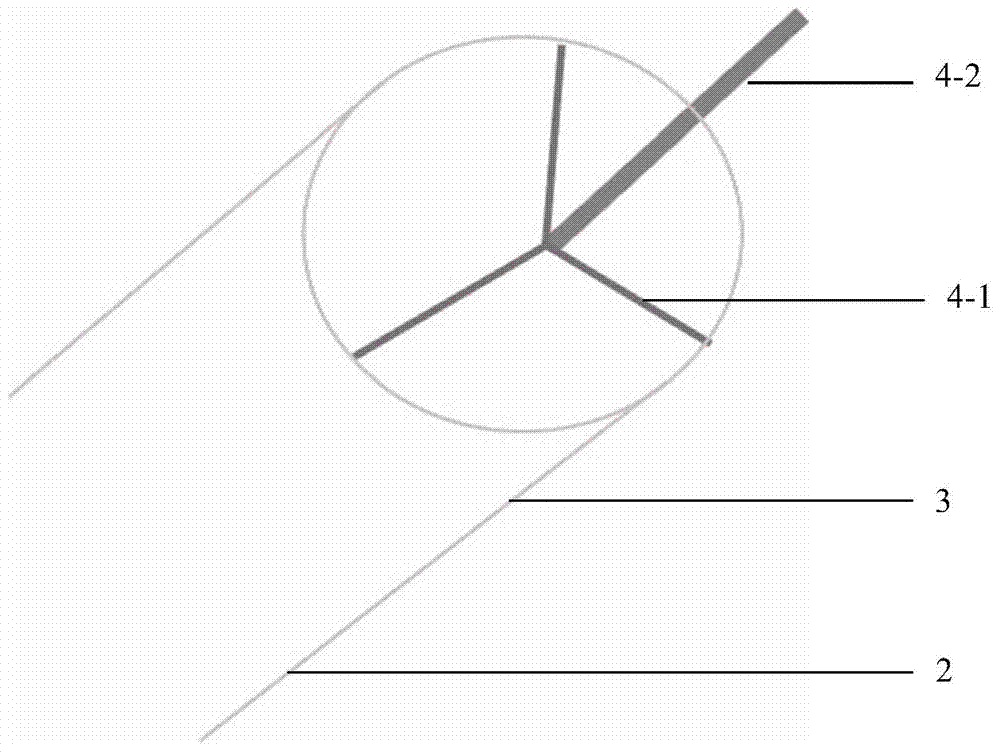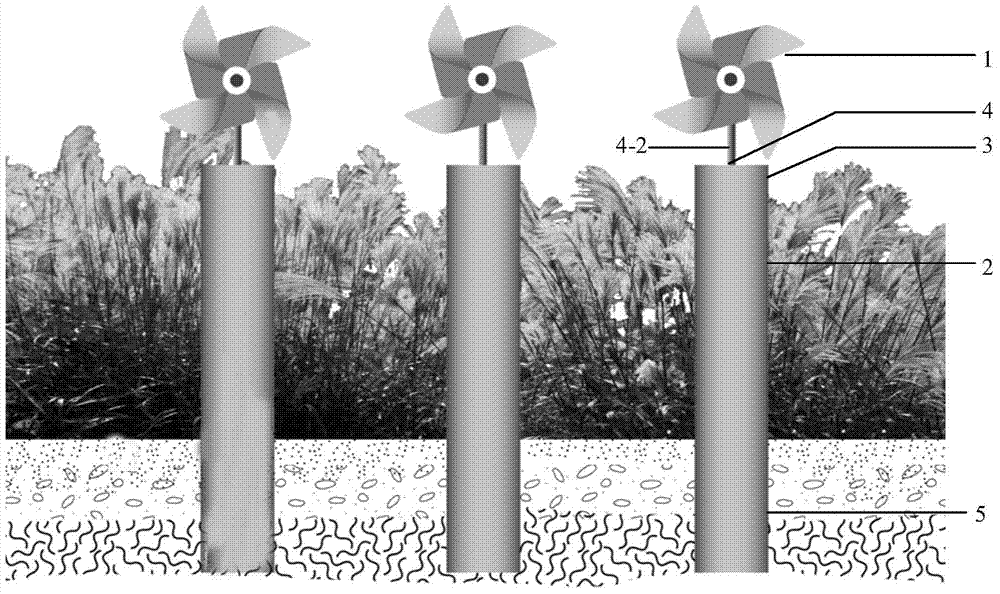Reaeration device and reaeration method for constructed wetland
A technology of artificial wetlands and wetlands, applied in the direction of biological treatment devices, chemical instruments and methods, and restoration of contaminated soil, etc., can solve the problem that the reoxygenation amount per unit of subsurface wetland matrix cannot meet actual needs, affect the purification effect of subsurface flow wetlands, and hydraulic retention Long time and other problems, to achieve the effect of simple structure, low maintenance cost and low cost
- Summary
- Abstract
- Description
- Claims
- Application Information
AI Technical Summary
Problems solved by technology
Method used
Image
Examples
Embodiment 1、1
[0033] Embodiment 1, No. 1 reoxygenation device
[0034] combine figure 1 , figure 2 and image 3 The No. 1 reoxygenation device for constructed wetlands based on this embodiment will be described in detail. The reoxygenation device comprises a windmill 1 and a reoxygenation pipe 2; the structural representation of the windmill 1 is as follows figure 1 Shown; specifically, in this embodiment, the number of the windmill 1 is one. The reoxygenation tube 1 is a tubular structure with openings at both ends, wherein the end inserted and fixed in the matrix of the constructed wetland is the insertion end 5, which is used to discharge the air in the reoxygenation tube into the matrix; The other end is a free end 3 for receiving air. Such as figure 2 As shown, the free end 3 and the windmill are provided with connecting parts that cooperate with each other for installing the windmill 1 on the free end 3 of the reoxygenation tube 2, and the mutual cooperation of the connecting ...
Embodiment 2、2
[0036] Embodiment 2, No. 2 reoxygenation device
[0037] combine figure 1 , Figure 4 and Figure 5 The No. 2 reoxygenation device based on this embodiment is further described. The No. 2 reoxygenation device includes a windmill 1 and a reoxygenation tube 2; the structural representation of the windmill 1 is as follows figure 1 Shown; Specifically, in this embodiment, the No. 2 reoxygenation device is provided with a windmill 1. The reoxygenation tube 2 includes a plurality of inner tubes 6 with openings at both ends, different inner diameters, and different lengths. The gap, from the outermost inner tube to the innermost inner tube, the inner tube insertion end 6-2 increases sequentially, the specific structure is as follows Figure 4 As shown; the reoxygenation device is prepared by an integrated molding process. This structure is convenient to insert into the wetland matrix, and the material is environmentally friendly and low in cost. Since the inner pipes 6 have dif...
Embodiment 3、3
[0039] Embodiment 3, No. 3 reoxygenation device
[0040] combine figure 1 , Figure 6 and Figure 7 The No. 3 reoxygenation device based on this embodiment is further described. The No. 3 reoxygenation device includes a windmill 1 and a reoxygenation tube 2; the structural representation of the windmill 1 is as follows figure 1 Specifically, in this embodiment, the No. 2 reoxygenation device is provided with two windmills 1 . The reoxygenation tube 2 includes a plurality of inner tubes 6 with openings at both ends and different lengths. The inner tubes are arranged in parallel, and there are gaps for air to flow between adjacent inner tubes. The specific structure is as follows: Figure 6 As shown; the reoxygenation device is prepared by an integrated molding process. This structure is convenient to insert into the wetland matrix, and the material is environmentally friendly and low in cost. Since the inner pipes 6 have different lengths, their insertion ends 6-2 can be i...
PUM
 Login to View More
Login to View More Abstract
Description
Claims
Application Information
 Login to View More
Login to View More - R&D
- Intellectual Property
- Life Sciences
- Materials
- Tech Scout
- Unparalleled Data Quality
- Higher Quality Content
- 60% Fewer Hallucinations
Browse by: Latest US Patents, China's latest patents, Technical Efficacy Thesaurus, Application Domain, Technology Topic, Popular Technical Reports.
© 2025 PatSnap. All rights reserved.Legal|Privacy policy|Modern Slavery Act Transparency Statement|Sitemap|About US| Contact US: help@patsnap.com



